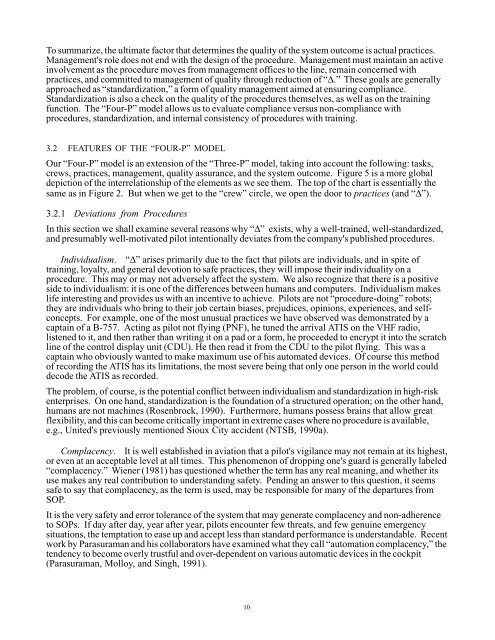On the Design of Flight-Deck Procedures - Intelligent Systems ...
On the Design of Flight-Deck Procedures - Intelligent Systems ...
On the Design of Flight-Deck Procedures - Intelligent Systems ...
Create successful ePaper yourself
Turn your PDF publications into a flip-book with our unique Google optimized e-Paper software.
To summarize, <strong>the</strong> ultimate factor that determines <strong>the</strong> quality <strong>of</strong> <strong>the</strong> system outcome is actual practices.Management's role does not end with <strong>the</strong> design <strong>of</strong> <strong>the</strong> procedure. Management must maintain an activeinvolvement as <strong>the</strong> procedure moves from management <strong>of</strong>fices to <strong>the</strong> line, remain concerned withpractices, and committed to management <strong>of</strong> quality through reduction <strong>of</strong> “∆.” These goals are generallyapproached as “standardization,” a form <strong>of</strong> quality management aimed at ensuring compliance.Standardization is also a check on <strong>the</strong> quality <strong>of</strong> <strong>the</strong> procedures <strong>the</strong>mselves, as well as on <strong>the</strong> trainingfunction. The “Four-P” model allows us to evaluate compliance versus non-compliance withprocedures, standardization, and internal consistency <strong>of</strong> procedures with training.3.2 FEATURES OF THE “FOUR-P” MODELOur “Four-P” model is an extension <strong>of</strong> <strong>the</strong> “Three-P” model, taking into account <strong>the</strong> following: tasks,crews, practices, management, quality assurance, and <strong>the</strong> system outcome. Figure 5 is a more globaldepiction <strong>of</strong> <strong>the</strong> interrelationship <strong>of</strong> <strong>the</strong> elements as we see <strong>the</strong>m. The top <strong>of</strong> <strong>the</strong> chart is essentially <strong>the</strong>same as in Figure 2. But when we get to <strong>the</strong> “crew” circle, we open <strong>the</strong> door to practices (and “∆”).3.2.1 Deviations from <strong>Procedures</strong>In this section we shall examine several reasons why “∆” exists, why a well-trained, well-standardized,and presumably well-motivated pilot intentionally deviates from <strong>the</strong> company's published procedures.Individualism. “∆” arises primarily due to <strong>the</strong> fact that pilots are individuals, and in spite <strong>of</strong>training, loyalty, and general devotion to safe practices, <strong>the</strong>y will impose <strong>the</strong>ir individuality on aprocedure. This may or may not adversely affect <strong>the</strong> system. We also recognize that <strong>the</strong>re is a positiveside to individualism: it is one <strong>of</strong> <strong>the</strong> differences between humans and computers. Individualism makeslife interesting and provides us with an incentive to achieve. Pilots are not “procedure-doing” robots;<strong>the</strong>y are individuals who bring to <strong>the</strong>ir job certain biases, prejudices, opinions, experiences, and selfconcepts.For example, one <strong>of</strong> <strong>the</strong> most unusual practices we have observed was demonstrated by acaptain <strong>of</strong> a B-757. Acting as pilot not flying (PNF), he tuned <strong>the</strong> arrival ATIS on <strong>the</strong> VHF radio,listened to it, and <strong>the</strong>n ra<strong>the</strong>r than writing it on a pad or a form, he proceeded to encrypt it into <strong>the</strong> scratchline <strong>of</strong> <strong>the</strong> control display unit (CDU). He <strong>the</strong>n read it from <strong>the</strong> CDU to <strong>the</strong> pilot flying. This was acaptain who obviously wanted to make maximum use <strong>of</strong> his automated devices. Of course this method<strong>of</strong> recording <strong>the</strong> ATIS has its limitations, <strong>the</strong> most severe being that only one person in <strong>the</strong> world coulddecode <strong>the</strong> ATIS as recorded.The problem, <strong>of</strong> course, is <strong>the</strong> potential conflict between individualism and standardization in high-riskenterprises. <strong>On</strong> one hand, standardization is <strong>the</strong> foundation <strong>of</strong> a structured operation; on <strong>the</strong> o<strong>the</strong>r hand,humans are not machines (Rosenbrock, 1990). Fur<strong>the</strong>rmore, humans possess brains that allow greatflexibility, and this can become critically important in extreme cases where no procedure is available,e.g., United's previously mentioned Sioux City accident (NTSB, 1990a).Complacency. It is well established in aviation that a pilot's vigilance may not remain at its highest,or even at an acceptable level at all times. This phenomenon <strong>of</strong> dropping one's guard is generally labeled“complacency.” Wiener (1981) has questioned whe<strong>the</strong>r <strong>the</strong> term has any real meaning, and whe<strong>the</strong>r itsuse makes any real contribution to understanding safety. Pending an answer to this question, it seemssafe to say that complacency, as <strong>the</strong> term is used, may be responsible for many <strong>of</strong> <strong>the</strong> departures fromSOP.It is <strong>the</strong> very safety and error tolerance <strong>of</strong> <strong>the</strong> system that may generate complacency and non-adherenceto SOPs. If day after day, year after year, pilots encounter few threats, and few genuine emergencysituations, <strong>the</strong> temptation to ease up and accept less than standard performance is understandable. Recentwork by Parasuraman and his collaborators have examined what <strong>the</strong>y call “automation complacency,” <strong>the</strong>tendency to become overly trustful and over-dependent on various automatic devices in <strong>the</strong> cockpit(Parasuraman, Molloy, and Singh, 1991).10
















